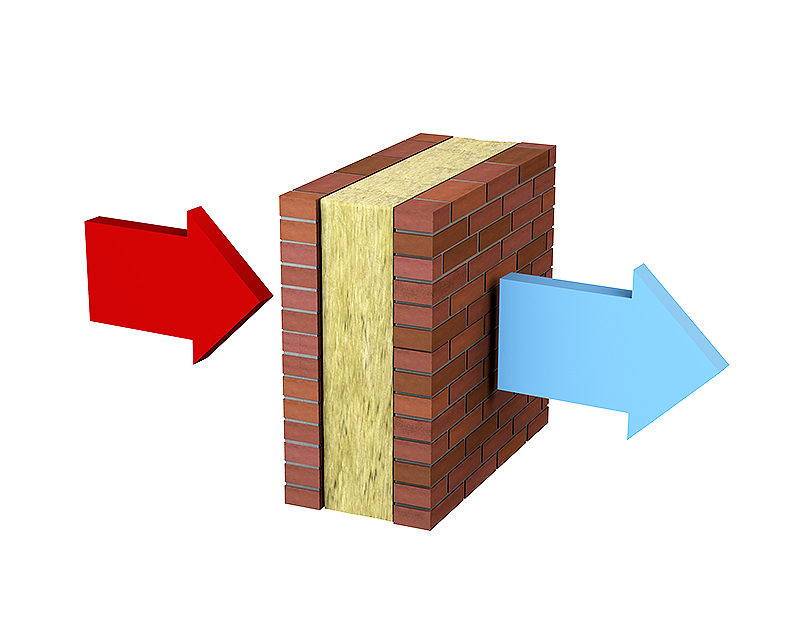There are numerous insulation solutions available and making the right choice for a specific project can be difficult when specifiers must consider all the options. In this article, Paul Barrett, Head of Product Management at ROCKWOOL UK, explains how to evaluate different insulation options using the data provided by manufacturers.
ROCKWOOL
The main function of insulation in buildings is temperature control. It is vital to keep the indoor climate comfortable and healthy, which means effective temperature regulation as opposed to simply keeping heat in. With the recent climate changes, hotter summers mean that insulation is also needed to keep the heat out. Without appropriate insulation, the increased demand to heat or cool buildings raises energy consumption, associated costs and CO2 emissions. Around 20% of greenhouse gas emissions in the UK are caused by heating buildings. The EU has calculated that proper insulation can reduce a building’s heating needs by up to 70%.
Building Regulations are clear about the level of insulation required for specific projects. There are different ways of using insulation to achieve the required thermal values and provide additional benefits.
Measuring thermal conductivity
The lambda (λ) value, also referred to as thermal conductivity, is a value indication of how well a material conducts heat. It indicates the quantity of thermal energy (W), which is conducted through a 1m² wall, in a thickness of 1m, when the difference in temperature between the opposite surfaces of this wall equals 1K (or 1ºC). In practice, thermal conductivity is a numerical value expressed in terms of W/(mK). The lower the thermal conductivity value, the better the insulation property of the material. For example, the thermal conductivity value of steel is 50W/mK, whereas wood has a λ value of 0.12W/mK.
A more commonly-used value to express the thermal performance of the building fabric is the U-value. The thermal transmittance coefficient, U, expresses the transport of thermal energy through a structure. It represents the flow of heat (in W) through 1m² of a structure, when the difference between the two surrounding temperatures is 1K (or 1ºC). The thermal transmittance coefficient is expressed in W/(m²K). The lower the coefficient, the better the structure insulates.
Finally, thermal resistance, R, is a measure regularly used in construction. The R-value is the reciprocal U-value. Increasing the thickness of an insulating layer increases the R-value.
Insulation manufacturers are constantly working on improving the lambda value of their products by developing new ways of reducing the conductivity of insulation materials. Manufacturers, like ourselves, are always looking to enhance their product range with new solutions that improve thermal performance. NyRock, the next generation of stone wool, is an example of this. Our engineers have created a stone-wool product with a more efficient fibre structure by enabling more air to remain between the fibres. This reduces its ability to conduct heat and brings the lambda value down to 0.032W/mK.
Decreasing the conductivity of insulation materials means that the thickness of the insulation can be reduced as well. When working to a U-value of 0.18W/m2K, specifiers can typically save around 15mm on the wall thickness with NyRock compared to traditional stone-wool products. Applying that saving over a 22 x 22m building of nine storeys, for example, can yield an extra 99ft2 of usable or profitable floor space.
Beyond the thermal performance – fire safety
While the driving force behind insulation specification is to regulate internal temperatures, the latest changes to Part B of the Building Regulations reflect the growing role of insulation in the fire safety of buildings. From 1st December 2022, buildings that are categorised as having a residential purpose and over 11m in height will require external wall insulation classified as A2-s1,d0 or better in the Euroclass fire performance rating. This means that the insulation material has to be non-combustible. All other buildings above 18m require insulation with a minimum classification of A2-s3,d0.
The Euroclass system determines a product’s fire performance by measuring a comprehensive set of characteristics, including ignitability, flame spread, heat release, smoke production and propensity for producing flaming droplets/particles. The classifications run from A1 to F, with products achieving A1 and A2-s1,d0 typically defined as non-combustible.
Acoustic performance of insulation
Another benefit of correctly-installed insulation is the protection from noise. In general, noise is any unwanted sound, independent of objective measurements. Growing population numbers mean more people live closely together in cities and houses of multiple occupancy. In these surroundings, insulation on all walls, floors and ceilings can considerably reduce noise pollution.
It is easy enough to measure the noise within a space after it has been built, but by then, remediation can be very difficult and expensive if required. As such, it is important to accurately measure noise levels during the planning phase to ensure that the building design will deliver the required acoustic environment once constructed.
Where projects utilise acoustic modelling in place of onsite environmental testing, a lack of real-world data can lead to over-engineered systems, which incorporate additional mass layers. The same is true of insulation products. To provide greater support when specifying stone-wool insulation for sound control, many ROCKWOOL products have been acoustically tested. The fibres in stone wool are randomly orientated, and as sound waves try to pass through the air trapped within the fibrous structure, they get absorbed by friction as the individual fibres are made to move back and forth. In addition, the random orientation of the fibres gives rise to high tortuosity, which makes it very difficult for sound to find a path from one side to the other.
Getting the specification of insulation right is important – for the comfort and safety of the building’s occupants and to comply with regulations. Classifications and test data help and the technical teams of insulation manufacturers will assist you through every phase of your project.









